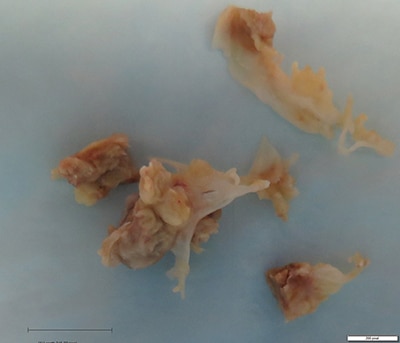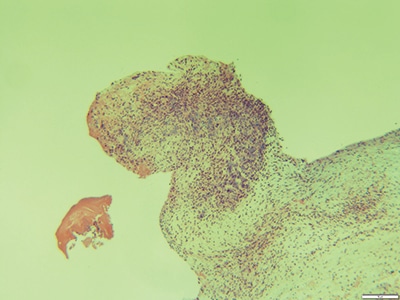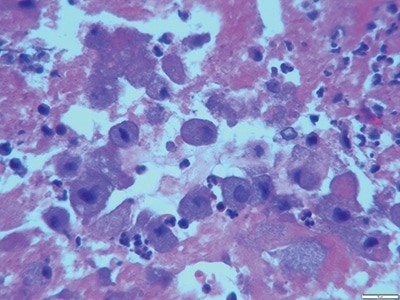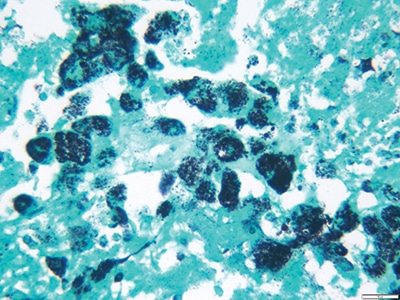CAP TODAY and the Association for Molecular Pathology have teamed up to bring molecular case reports to CAP TODAY readers. AMP members write the reports using clinical cases from their own practices that show molecular testing’s important role in diagnosis, prognosis, and treatment. The following report comes from University Hospitals Cleveland Medical Center and Case Western Reserve University School of Medicine. If you would like to submit a case report, please send an email to the AMP at amp@amp.org. For more information about the AMP and all previously published case reports, visit www.amp.org.
Catherine M. Stefaniuk, DO
Daniel D. Rhoads, MD
Michael R. Jacobs, MB BCh, PhD
September 2020—A 64-year-old male presented with worsening shortness of breath, dry cough, and bilateral leg edema. He had a history of diabetes mellitus type two, hypertension, seropositive rheumatoid arthritis, and tobacco and alcohol abuse. CT scan demonstrated bilateral pleural effusions, pulmonary edema, subsegmental atelectasis, mildly enlarged hilar lymph nodes, mild cardiomegaly with a small pericardial effusion, and liver cirrhosis with a liver nodule. A hepatitis panel demonstrated positive serology for hepatitis C virus infection. Ultrasound-guided core biopsies of liver nodule demonstrated hepatocellular carcinoma. Endoscopy demonstrated grade one esophageal varices and a gastric ulcer. Biopsy of the gastric ulcer demonstrated acute and chronic inflammation with presence of Helicobacter pylori.
The patient was started on a proton pump inhibitor, amoxicillin, and clarithromycin. Transthoracic echocardiogram noted a 7.6-mm lesion on the aortic valve. Transesophageal echocardiogram demonstrated aortic valve leaflets to be severely thickened with reduced systolic excursion and oscillating vegetations on two cusps suggestive of endocarditis. Patient denied history of worsening arthralgias, nausea, vomiting, weight loss, swimming, travel, hunting, dental procedures, sick contacts, or animal contacts. He did admit to a two- to three-month history of night sweats. Multiple blood cultures were negative. Patient was taken to surgery to replace the aortic valve; vegetations were present on all three aortic valve leaflets, with destruction of the right coronary and noncoronary cusps. The excised aortic valve was submitted for culture, histology, and molecular analysis.
Details of the pathology. Grossly, aortic valve leaflets were fragmented with a fibrotic thickened surface covered by vegetations and calcifications (Fig. 1). Microscopic examination demonstrated multiple foci of acute and chronic inflammation of valve leaflets, with cusp destruction and marked infiltration by basophilic foamy macrophages and multinucleated giant cells, admixed with acute inflammation in necrotic debris (Figs. 2 and 3). Myxoid degenerative changes with dystrophic calcifications and hemosiderin-laden macrophages were also present.
Grocott’s methenamine silver stain (GMS) demonstrated thin bacilli within macrophages in areas of acute inflammation and necrotic debris (Fig. 4). Periodic acid-Schiff stain (PAS) revealed macrophages with abundant PAS-positive inclusions (Fig. 5). Both Gram and acid-fast stains (Ziehl-Neelsen stain) were negative. All cultures were also negative. These findings favored Tropheryma whipplei infection. Since PAS and GMS are nonspecific, molecular analysis was sought to prove this diagnosis.

Fig. 1. Aortic valve leaflets with vegetations present (black bar = 1 cm).

Fig. 2. Aortic valve vegetation with the presence of abundant macrophages with a basophilic hue (2×).

Fig. 3. Hemotoxylin and eosin stain: numerous macrophages with abundant basophilic foamy cytoplasm (40×).

Fig. 4. Grocott’s methenamine silver stain: macrophages staining positive with T. whipplei bacilli cell wall material (40×).

Fig. 5. Periodic acid-Schiff stain: macrophages staining positive with T. whipplei bacilli cell wall material (40×).
Clinical impact. The patient had endocarditis due to Tropheryma whipplei. He was started on penicillin G and then switched to trimethoprim-sulfamethoxazole. He presented in a complicated setting of rheumatoid arthritis, immunosuppression, congestive heart failure, liver cirrhosis, HCV, hepatocellular carcinoma, and Helicobactor pylori infection. If the patient had not had an echocardiogram performed because of his heart failure, his diagnosis of endocarditis would have been delayed because blood cultures were negative.
 CAP TODAY Pathology/Laboratory Medicine/Laboratory Management
CAP TODAY Pathology/Laboratory Medicine/Laboratory Management
